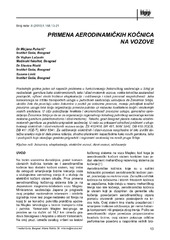Primena aerodinamičkih kočnica na vozove
Application of the aerodynamical brakes on trains
| dc.creator | Puharić, Mirjana | |
| dc.creator | Lučanin, Vojkan | |
| dc.creator | Ristič, S. | |
| dc.creator | Unič, S. | |
| dc.date.accessioned | 2022-09-19T16:23:10Z | |
| dc.date.available | 2022-09-19T16:23:10Z | |
| dc.date.issued | 2010 | |
| dc.identifier.issn | 1451-4117 | |
| dc.identifier.uri | https://machinery.mas.bg.ac.rs/handle/123456789/995 | |
| dc.description.abstract | This paper presents the aerodynamical brake system, as second brake system, in cases when it is necessary to speed down the train or at emergency situations when primary brake system Is out of order. In this brake system, braking force is a result of aerodynamical drag generated on pulled-up aerodinamical brake panels. These panels are especially effective at high speeds because aerodynamical drag of panels is proportional to second exponent of vehicle's speed. Calculation of braking force by panel surface unit was derived for the aerodynamical brake of concave shape and it was compared with test results for Maglev train on railway Yamanashy in Japan. | en |
| dc.publisher | Institut za istraživanja i projektovanja u privredi, Beograd | |
| dc.relation | info:eu-repo/grantAgreement/MESTD/MPN2006-2010/14018/RS// | |
| dc.rights | openAccess | |
| dc.rights.uri | https://creativecommons.org/licenses/by/4.0/ | |
| dc.source | Journal of Applied Engineering Science | |
| dc.subject | Train | en |
| dc.subject | Aerodynamics brakes | en |
| dc.subject | Aerodynamic drag | en |
| dc.title | Primena aerodinamičkih kočnica na vozove | sr |
| dc.title | Application of the aerodynamical brakes on trains | en |
| dc.type | article | |
| dc.rights.license | BY | |
| dc.citation.epage | 21 | |
| dc.citation.issue | 1 | |
| dc.citation.other | 8(1): 13-21 | |
| dc.citation.rank | M52 | |
| dc.citation.spage | 13 | |
| dc.citation.volume | 8 | |
| dc.identifier.fulltext | http://machinery.mas.bg.ac.rs/bitstream/id/2828/992.pdf | |
| dc.identifier.rcub | https://hdl.handle.net/21.15107/rcub_machinery_995 | |
| dc.identifier.scopus | 2-s2.0-84857906393 | |
| dc.type.version | publishedVersion |


